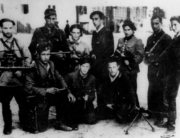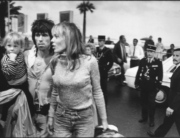![]() A captivating look at one of the great successes of the Soviet experiment, Red Army uncovers how the Soviet Union’s ice hockey team dominated world competition to an unprecedented extent in the 1970s and ‘80s. It featured a core of players dubbed the Russian Five, including defenseman Viacheslav (Slava) Fetisov. The American press later dubbed them “The Wizards of Ov” in the late ’90s when a modified version of the group played for the Detroit Red Wings, helping the team win back-to-back Stanley Cups.
A captivating look at one of the great successes of the Soviet experiment, Red Army uncovers how the Soviet Union’s ice hockey team dominated world competition to an unprecedented extent in the 1970s and ‘80s. It featured a core of players dubbed the Russian Five, including defenseman Viacheslav (Slava) Fetisov. The American press later dubbed them “The Wizards of Ov” in the late ’90s when a modified version of the group played for the Detroit Red Wings, helping the team win back-to-back Stanley Cups.
The legendary 1980 Lake Placid defeat at the hands of the upstart Americans is treated fairly briefly as the anomaly it turns out it really was. In the American historical narrative, it is the event in the later years of the Cold War. In the Soviet Union, it was evidence of a flaw in the system, and changes were made. Viktor Tikhonov, a ruthless, high-ranking KGB officer, took over as coach, and had none of the inspiring creativity of Anatoli Tarasov, the Baryshnikov of ice hockey, who had mentored and molded the Russian Five. There’s lots of footage of Tarasov’s playful coaching methods, where his young players do things on ice that you’ve probably never seen a hockey player do.
There is fascinating footage of the merciless exercise and practice regimes Tikhonov put his players through after losing at Lake Placid. Players spent 11 months in a confined hockey camp, practicing more than 10 hours a day, often until they pissed blood. It’s beyond cartoonish to see video of the Soviet players lifting weights so fast; you expect every rep to be the one that will pop a disc. When the ’84 Olympics came around, the Soviets demolished everyone, even the vaunted Canadian team featuring Wayne Gretzsky and Guy Lafleur, who admitted in an interview after their defeat that just couldn’t compete with the big Red Army machine. Hockey had never been played on that level before, and probably not since.
The Soviets had a comprehensive system in place for selecting the absolute best of the best from their enormous population base and a vast system for turning them into ideal parts of a perfect hockey machine. They treated the sport like a crucial part of society and played it with complex strategies. One of the barriers to hockey attaining the popularity level of basketball or football in the U.S. is how plays seem to break down so often and rarely have the time or space to really stretch out and develop. If a play was not carried out correctly, the Soviets would actually pass the puck back to their own end, so they could start the entire play again, and do it perfectly from start to finish. It’s sports as realization of a political philosophy.
Much of the humor in the film comes from director Gabe Polsky’s American values being completely alien to the Russians. He repeatedly asks one player, Vladimir Krutov, about his teammates, what were their hobbies and personalities? Krutov looks bewildered and almost offended, and just states that they were all the same and wonders why Polsky keeps asking this question.
The star of the film is Slava Fetisov, who is probably one of the better things the USSR ever produced, and not just because of his resemblance to Phil Hartman and his fondness for calmly flipping people off, including the director at the start of the film. He keeps that attitude more or less intact. He casually insults Polsky throughout, but in a charmingly arrogant, rather than mean-spirited, way, just as the inevitable result of their different values. It’s an eye-opening look at Russian humor, which doesn’t seem to come from intentional sarcasm or jokes, but the inevitable hilarity ensuing from confrontations between opposites.
Years of playing under the tyrannical Tikhonov regime made Fetisov yearn for the better life the National Hockey League offered. But this was a highly charged act, and required an enormous amount of political maneuvering at the highest levels to accomplish. Determined to win the right to make his own fortune and enjoy American comforts, Fetisov faced off with Soviet Minister of Defense Dmitry Yazov, the second most powerful man in the Soviet Union, who really could not look any more hardline.
It’s pretty unbelievable to see how closely politics and sports were intertwined in the USSR, and Red Army provides a strong sense of how the state controlled every aspect of life. The story of the Russian Five is a perfect way to learn about the culture of the Soviet Union, with the high highs and low lows all presented side by side.







Leave A Comment